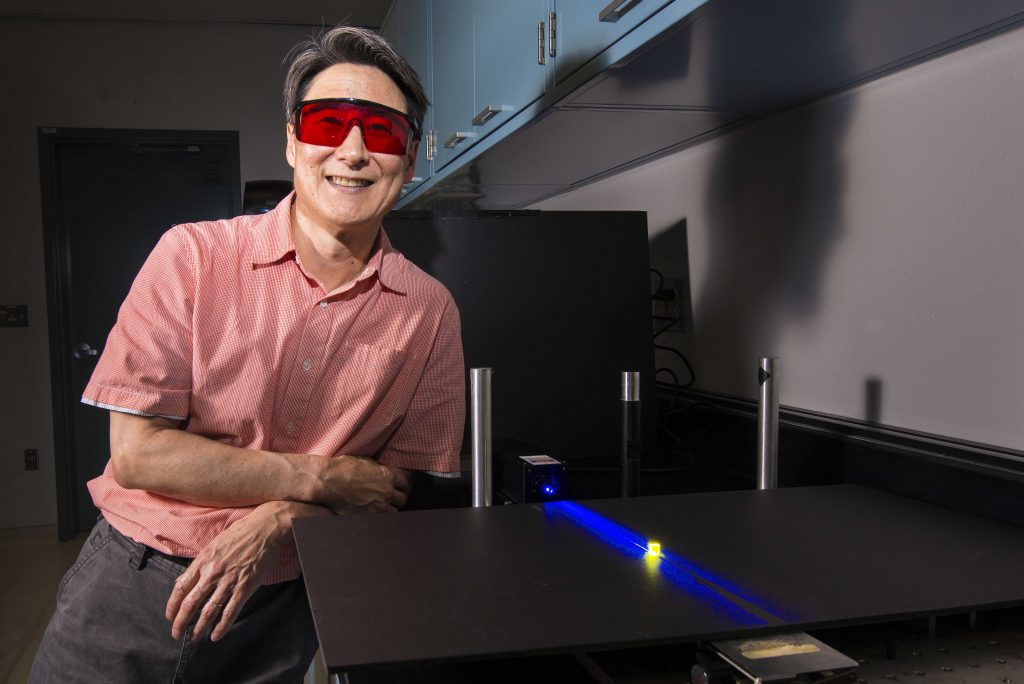ALBUQUERQUE, N.M. – Jeff Tsao has seen it all in his 29-year Sandia National Laboratories career, from research to management to entrepreneurship. But being an idea guy is what he likes best. “It’s what I naturally gravitate toward,” Tsao said.
Tsao is a researcher in the solid-state lighting group, working to cut back the worldwide cost of electricity by using semiconductor light-emitting diodes as sources of illumination instead of electrical filaments, plasma or gas.

This year Tsao became the 13th Sandia staff member honored with an Asian American Engineer of the Year (AAEOY) award. The prestigious recognition program was started in 2001 by the Chinese Institute of Engineers-USA to honor outstanding Asian American professionals in science and engineering for their leadership, technical achievement and public service.
This year’s 12th annual event was held March 2 in Dallas as a finale to National Engineers Week. Albuquerque hosted the 2012 AAEOY last March with Sandia President and Laboratories Director Paul Hommert as keynote speaker.
Since 2002, some 160 engineers from leading U.S. technology corporations, research institutions and the U.S. Armed Forces have received the AAEOY award, including seven Nobel laureates.
“Getting this award is an amazing honor,” Tsao said.
Tsao is a Los Angeles native who attended Stanford University, earning in four years a bachelor’s in math and a master’s in electrical engineering. Grad school took him to the opposite side of the country and Harvard University.
“Harvard was great, but that first year was tough coming from perfect weather in California,” he said. “My first winter in Boston was the famous blizzard of ’78. The storm was so bad that Harvard had to shut down. Here I was this California kid wearing flip flops. I figured I’d better get some real shoes.”
With a doctorate in applied physics in hand, Tsao arrived at Sandia in 1984. He had a background in lasers, laser spectroscopy and quantum electronics, and a strong interest in materials science. He joined a project involving pulsed laser annealing of silicon to look at the dynamics of ultra-fast crystal growth. He later switched to a study of crystal growth on a slower time scale using a then-emerging technique, molecular beam epitaxy.
Tsao wrote a book, “Materials Fundamentals of Molecular Beam Epitaxy,” and in the early 1990s became a manager in Sandia’s Microelectronics and Microsystems center. About seven years later, aware of the commercial potential of semiconductor materials and devices, he took an entrepreneurial leave of absence to work at a small Los Angeles startup company that made fiber optic communications components.
“I spent a year there,” Tsao said. “I wanted to see how the high-tech world functioned.”
He returned to Sandia in 2001 as a researcher in the solid state lighting group. “It was the beginning of a new field,” Tsao said. “At first nobody had a clue if it would take off. It was kind of a dream, but we could see the potential. Now nobody has any doubt it will pretty much replace every light bulb on Earth.”
Jerry Simmons, senior manager of Sandia’s Semiconductors and Optical Sciences department, said Tsao was one of the first people to push for a national initiative in solid-state lighting, coauthoring a white paper on the topic in 1999 with Jeff Nelson of Sandia and Fred Kish and Roland Haitz of Hewlett Packard.
In subsequent years, Tsao was instrumental in helping identify and articulate the major science and technology research challenges for solid-state lighting. Simmons said Tsao also did an “amazing” study on the consumption of light across several continents going back 300 years, showing that humanity tends to spend roughly 0.7 percent of its gross domestic product on lighting, regardless of its efficiency or of standard of living.
Tsao said his career has spanned a wide range of work, from in-the-lab experimental science to management and entrepreneurship to serving the larger research community through papers, roadmaps and forward-looking ideas.
“Most importantly, it’s been full of wonderful friends, colleagues, and managers,” he said. “And for that I am grateful.”
